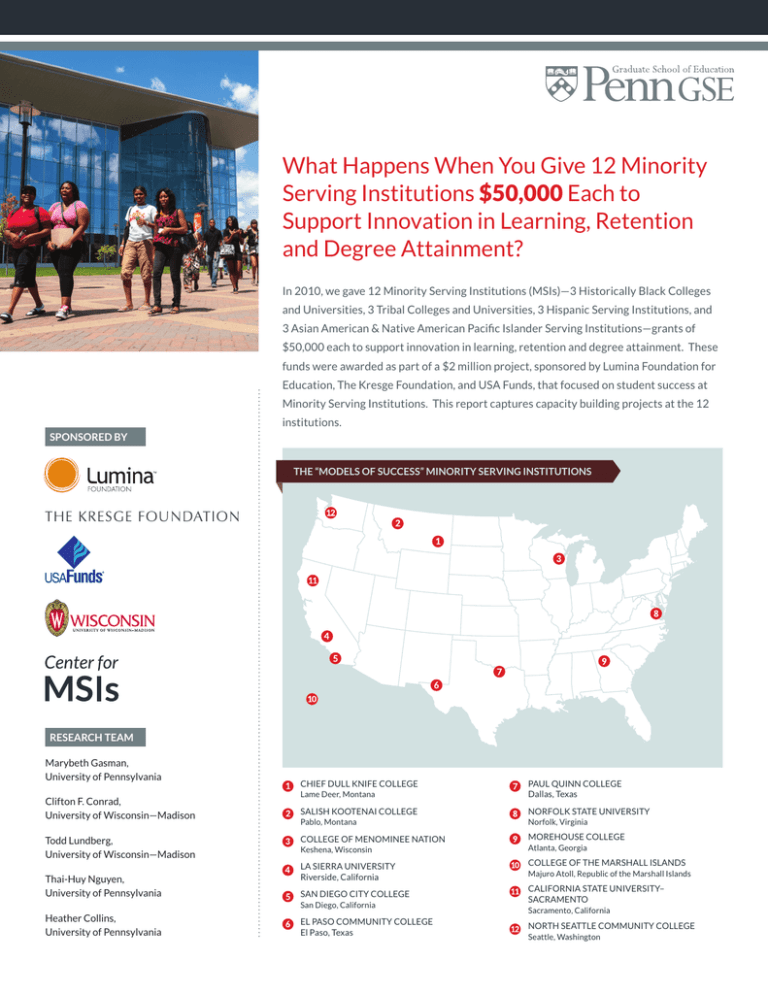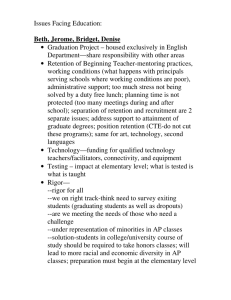What Happens When You Give 12 Minority $50,000 and Degree Attainment?
advertisement

What Happens When You Give 12 Minority Serving Institutions $50,000 Each to Support Innovation in Learning, Retention and Degree Attainment? In 2010, we gave 12 Minority Serving Institutions (MSIs)—3 Historically Black Colleges and Universities, 3 Tribal Colleges and Universities, 3 Hispanic Serving Institutions, and 3 Asian American & Native American Pacific Islander Serving Institutions—grants of $50,000 each to support innovation in learning, retention and degree attainment. These funds were awarded as part of a $2 million project, sponsored by Lumina Foundation for Education, The Kresge Foundation, and USA Funds, that focused on student success at Minority Serving Institutions. This report captures capacity building projects at the 12 institutions. Sponsored by The “Models of Success” Minority Serving Institutions Research Team Marybeth Gasman, University of Pennsylvania Clifton F. Conrad, University of Wisconsin—Madison Todd Lundberg, University of Wisconsin—Madison Thai-Huy Nguyen, University of Pennsylvania Chief Dull Knife College Lame Deer, Montana Salish Kootenai College Norfolk State University Pablo, Montana Norfolk, Virginia College of Menominee Nation Morehouse College Keshena, Wisconsin Atlanta, Georgia La Sierra University Riverside, California College of the Marshall Islands San Diego City College San Diego, California Heather Collins, University of Pennsylvania Paul Quinn College Dallas, Texas El Paso Community College El Paso, Texas Majuro Atoll, Republic of the Marshall Islands California State University– Sacramento Sacramento, California North Seattle Community College Seattle, Washington capaciTy building projecTS minoriTy Serving inSTiTuTionS (mSis): an overview Minority Serving Institutions emerged in response to a history of inequity, lack of minority people’s access to majority institutions, and significant demographic changes in the country. Now an integral part of American higher education, MSIs—specifically Historically Black Colleges and Universities (HBCUs), Tribal Colleges and Universities (TCUs), Hispanic Serving Institutions (HSIs), and Asian American and Native American Pacific Islander Serving Institutions (AANAPISIs) — have carved out a unique niche in the nation: serving the needs of low-income and underrepresented students of color. These institutions boast diverse faculties and staffs, provide environments that significantly enhance student learning and cultivate leadership skills, offer role models of various racial and ethnic backgrounds, provide programs of study that challenge students, address deficiencies resulting from inadequate preparation in primary and secondary school, and prepare students to succeed in the workforce and in graduate and professional education. Because MSIs enroll a substantial share of minority students, many of whom might not otherwise attend college, the continuous development and success of these institutions is critical for realizing our nation’s higher education and workforce goals and for the benefit of American society. MSIs play vital roles for the nation’s economy, especially with respect to elevating the workforce prospects of disadvantaged populations and reducing the underrepresentation of minorities and disadvantaged people in graduate and professional schools and the careers that require post baccalaureate education and training. “The grant funds gave us the luxury of having time to think about the outof-the-box ideas that could help our students, and the ability to implement these ideas. We could try things out and see whether or not they were working and then move in other directions. Once we had settled on the idea of the math lab approach, it became clear that we had to have a certain level of facilities and equipment to make it work. We couldn’t do it with broken down computers and the grant helped us refit the math lab. Our average number of certifications completed per week in the math lab has nearly tripled. Students are far more energetic and engaged than at any time in the last eight years.” JiM Bertin Chief Dull Knife College capaciTy building projecTS Like many of our nation’s Minority Serving Institutions, the colleges and universities in this study are serving students who often have had limited success in their prior academic experience and face significant financial, social, and cultural barriers in attaining a college degree. In turn, these MSIs are investing in innovations to make college accessible to every student who is ready to pursue a college education. But access is not enough. For these institutions, student success is also defined as achievement of educational milestones that matter to students and their communities— they expect program innovations to result in stronger academic performance, deeper engagement, and organizational cultures that push-and-pull whole cohorts of students to complete programs and realize their goals. The innovative programs and interventions profiled here are having a significant impact on student progress toward these milestones. chief dull knife college The Moving Minds project focuses on improving student cognition and comprehension through a multi-pronged effort that included both the mathematics and communication departments. Members of the project also assessed and improved how math remediation occurs at CDKC, with the introduction of a full time math lab. college of menominee naTion Inspired by the book Reclaiming Youth at Risk by Martin Brokenleg and the Supplementary Instructor Model created by the University of Missouri, Kansas City, the College of Menominee Nation created an academic support program that used peer and professional tutors. The academic tutoring assistance provided through this program, and supported by the Models of Success grant, is focused on creating a learning community where each person offers to share their strengths and graciously accepts what is offered. “As a Tribal College, part of our mission is to infuse higher education with American Indian culture. One of the strengths of the culture is the emphasis placed on how each individual can contribute to the community. When we focused on tutoring, we looked at what each person could give rather than what they would receive. This perspective allowed us to meet the needs of our students—emotionally, physically, mentally, and spiritually.” JenniFer Morris College of Menominee Nation 2 Capacity Building Projects El Paso Community College EPCC has launched a suite of programs—The College Readiness Initiative, the Pretesting Retesting Educational Program, Early College High Schools, and the Math Emporium—all designed to reduce the time or help students completely test out of developmental education courses, increase access and opportunity to enroll in college level courses and succeed. These programs, supported in part by funds from the Models of Success grant, illustrate EPCC’s commitment to student success and have shown evidence-based outcomes to support students. La Sierra University “Funding from the Models of Success grant enabled North Seattle Community College to further refine and then pilot a program that had never made it past the conceptual stage due to lack of start-up funding. In examining student drop-off points at the college, developmental math and English were clear areas where a high percentage of students were not succeeding and passing their classes, thus preventing them from moving forward with their certificate or degree. Even more concerning was the significant presence of students of color in these classes who were simply not being successful. Staff heard regularly from students and faculty that the students were often unaware of the academic and personal resources available to them on campus that would greatly improve their chances of being successful. Students did not know how to navigate the different offices, systems, and policies on campus. At its heart the NorthStar Peer Navigators program recognizes the power of peer to peer interactions and the need for culturally competent services that meet the needs of our diverse student population.” Jennie Dulas North Seattle Community College The First-Year Experience (FYE) program was developed in 2007 to increase retention rates of first-year students by providing academic, career and financial planning support. Funds from the Models of Success grant bolstered the FYE program. The program also implemented an early alert intervention system and partnered with parents to leverage additional support for students. In six years, the program has expanded services (mentoring, career development, and financial literacy) to all students at La Sierra University, fulfilling its goal of achieving high levels of student success as means to improve college completion. College of the Marshall Islands Engaging key principles of a “seamless” residential education program has important benefits to academic success for the vastly underprepared students from the Marshall Islands. In this small Pacific-island nation, higher education can be vital for the success of individuals, families, communities, the nation, and the culture. Funds from the Models of Success grant supported expanding and sustaining the residential education program. Morehouse College The International Research Experience served as a pilot summer international research training experience for STEM undergraduate students entering their junior years at Morehouse College. The primary goal of the experience was to provide undergraduate students with an inquiry-based, faculty-mentored research experience to enhance critical and analytical thinking, problem-solving and writing skills. The experience results in a research presentation that students present upon return to the U.S. Norfolk State University The First-Year Experience (FYE)/ACCESS Summer Bridge Program was initiated to help academically challenged students make the transition from high school to college. The goal of the program, which is supported and sustained in part by the Models of Success grant, is to improve student academic readiness, build peer-to-peer camaraderie, develop rapport with faculty and staff, and receive the developmental training needed to manage the rigors of college life. North Seattle Community College The goal of the NorthStar Peer Navigators program, supported in part by the Models of Success grant, is to increase the retention, persistence and completion rates of underrepresented student populations. The program pairs successful student “navigators” from underrepresented groups with new students to assist them with tutoring, navigating campus departments, and connecting students with internship and job opportunities. 3 Capacity Building Projects “In the Quinnite Nation, our ethos is WE over Me. In other words, the needs of the community supersede the wants of the individual. A wonderful example of this philosophy is our “Leave No Quinnite Behind” initiative. The program calls for a complete institutional approach to retention. Faculty and staff as well as high-performing students understand that it is their mission to assist our lessprepared students through completion of a college education. The investment from Models of Success grant allowed us to enhance our Student Support Services Center and make it the physical focal point of our program.” Michael J. Sorrell Paul Quinn College Paul Quinn College With the support of funds from the Models of Success program, the “Leave No Quinnite Behind” program aligns all student retention efforts on campus to improve outcomes and establish a centralized location for students to go for assistance. The student support center provides advising, tutoring, small group workshops, study space and a computer lab. “Leave No Quinnite Behind” also provides programming for students that increases awareness of the center on campus and encourages students to use its services. California State University, Sacramento The Full Circle Project, supported in part by the Models of Success program, is a comprehensive approach by California State University, Sacramento to implement a strategically focused, campus-wide effort to improve retention and graduation rates of Asian American and Pacific Islander students. This project provides strong advising support, planned leadership options and co-curricular service learning both on and off campus to enhance the university experience. Salish Kootenai College The Model of Success grant at Salish Kootenai College facilitated the creation of a Pathways to College Success Initiative. The Salish Summer Bridge scaled previous efforts to increase persistence of underprepared students through data-driven decision-making and multidisciplinary teamwork. The resulting Springboard Education Program blends holistic, culturally congruent services for pre-college students while accelerating them on a path to college success. San Diego City College With funds from the Models of Success grant, staff at San Diego City College strengthened the existing First Year Experience program by introducing an experiential learning center that provides validating experiences for students outside the classroom. The program began with adding service learning to the Title V funded First Year Experience program and providing supplemental instruction in developmental English and math. “As a community college counselor, one particularly concerned with career and leadership development, I have observed the power that engaging in purposeful community service has for college students, particularly those from generational poverty, in increasing their sense of personal efficacy, their values, and their awareness of the world. The funds from the Models of Success grant allowed us to provide students with a strong focus on career decision-making and community service.” Cassie Morton “The Full Circle Project utilized capacity building funds to implement a strategically focused, campus-wide effort to improve retention and graduation rates of Asian American and Pacific Islander students. In particular, we implemented several planned leadership options and co-curricular service learning both on and off campus to enhance the university experience for students.” San Diego City College Tim Fong California State University–Sacramento 4 Capacity Building Projects Common Strategies Across the MSI Models of Success capacity building projects four common strategies emerged: Make learning a community matter. The programs in which these institutions are investing in are overwhelmingly programs that establish cohorts, groups of students and teachers who take responsibility for moving together toward shared goals. Students are not competitors for scarce resources but resources for one another. It is telling that in these programs the students who become tutors and Supplemental Instructors experience some of the strongest growth. Structure a pathway. While many of these initiatives scaffold first-year experiences that build momentum for underprepared and traditionally underrepresented students, several of these MSIs have developed programs that prepare successful upper-division students to negotiate new challenges as they enter careers or graduate education. Multiply teaching and learning resources. These programs represent cuttingedge implementations of Supplemental Instruction, computerized courseware, tutoring, cohorts, and service learning. The MSIs in this study share an awareness that learning does not happen only or even best inside classrooms, and they are experimenting with ways to make learning part of a common endeavor engaged in by faculty, staff, administrators, and students across their campuses. Assess student progress and learning. Assessment of student progress is integral to these projects. As part of their design, each institution gathers information about what students are doing, where they are succeeding, and what additional support they need. This information comes in the form of courseware analytics, attendance, survey results, scores and grades, student publications and projects, tutor and staff debriefs, and student reflections. Student learning and progress matters at these institutions. They evaluate student performance and use what they learn to roll out new interventions, tweak existing programs, and help their constituencies understand what it takes for students to get an education that “matters” to them and to their communities. 5


